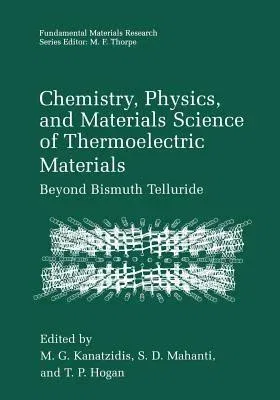This seriesofbooks, which is publishedattherateofaboutoneper year,
addresses fundamental problems in materialsscience.Thecontents
coverabroadrangeoftopicsfromsmallclustersofatomstoengineering materials
and involve chemistry, physics, materials science, and engineering,
withlengthscalesrangingfromAngstromsuptomillimeters. Theemphasis is on
basic scienceratherthan on applications. Each book focuses on a single
areaofcurrent interest and brings together leading experts to give an
up-to-date discussion oftheir work and the workof others. Each
articlecontainsenough references thattheinterestedreader can access the
relevant literature. Thanks are given to the Center for Fundamental
Materials Research at Michigan State University for
supportingthisseries. M.F.Thorpe, SeriesEditor E-mail: thorpe@pa.msu.edu
EastLansing, Michigan, November2002 v PREFACE
ThisvolumerecordsinvitedlecturesgivenattheNewThermoelectric(TE)Materials
Workshopheld inTraverseCity, MichiganfromAugust17-21,2002.Thethemeofthe
workshop was Chemistry, PhysicsandMaterials ScienceofThermoelectric
Materials: Beyond Bismuth Telluride. The objective of this symposium was
threefold. First, to examine and assess the ability of solid state
chemistry to produce new generation materials for TE applications.
Second, to rationalize and predict the charge and heat
transportpropertiesofpotentialcandidatesandhypotheticalsystemsthroughsolidstate
theoryandexperiment.Third,
toidentifyandprioritizeresearchneededtoreachvarious
levelsofrequirementsintermsofZTandtemperature.Theseobjectiveswereaddressed
by a series of invited talks and discussions by leading experts from
academia, governmentlaboratories, andindustry.
Thereweretwenty-twoinvitedandeightposterpresentations inthe workshop.Out
ofthese,
sixteeninvitedpresentationsarerepresentedinthisvolume.Theycoverawide
range of subjects, starting from synthesis (based on different
strategies) and characterizationofnovel materials to acareful
studyoftheir transport properties and
electronicstructure.Topicsaddressingtheissueofmakingnew materialsare:
synthetic search for new materials (di Salvo et aI.) and synthetic
strategies based on phase homologies (Kanatzidis). The different classes
of materials covered are: bismuth nanowires (Dresselhausetal.),
unconventional high-temperaturethermoelectrics, boron carbides (Aselage
et aI.), layered cobalt oxides (Fujii et aI.), early transition metal
antimonides(KleinkeetaI.), skutterudites(Uher),
andclathratethermoelectrics(Nolas).

